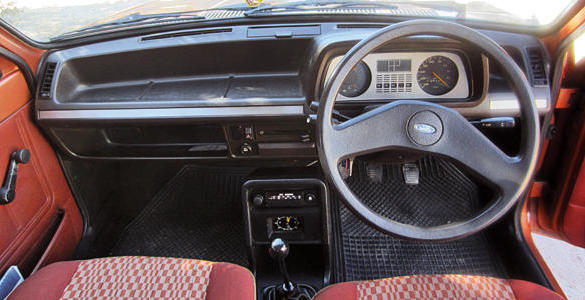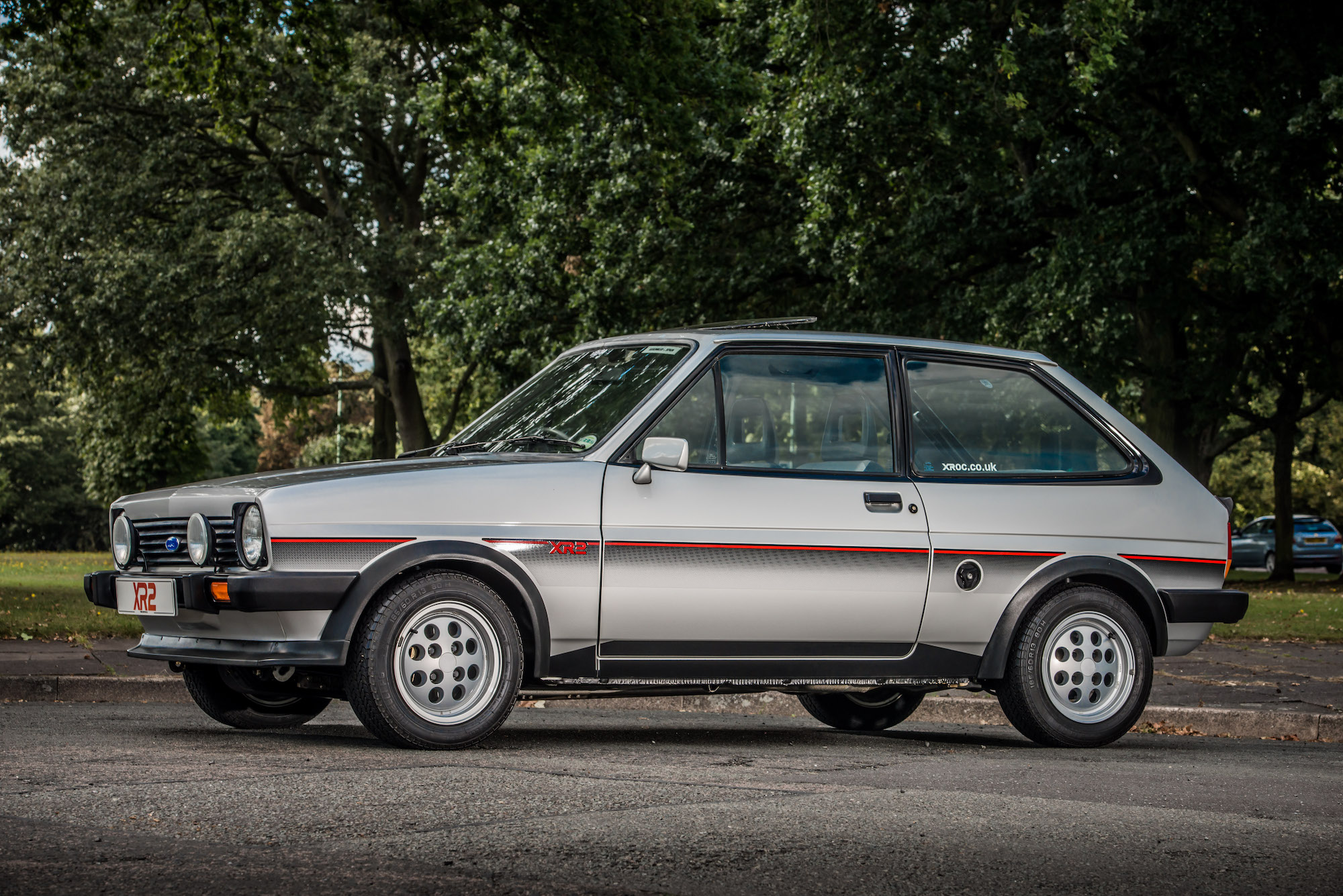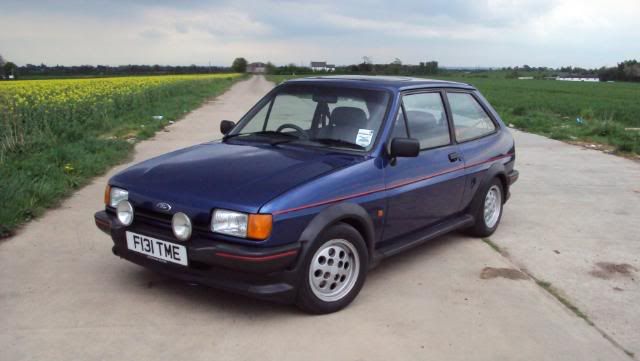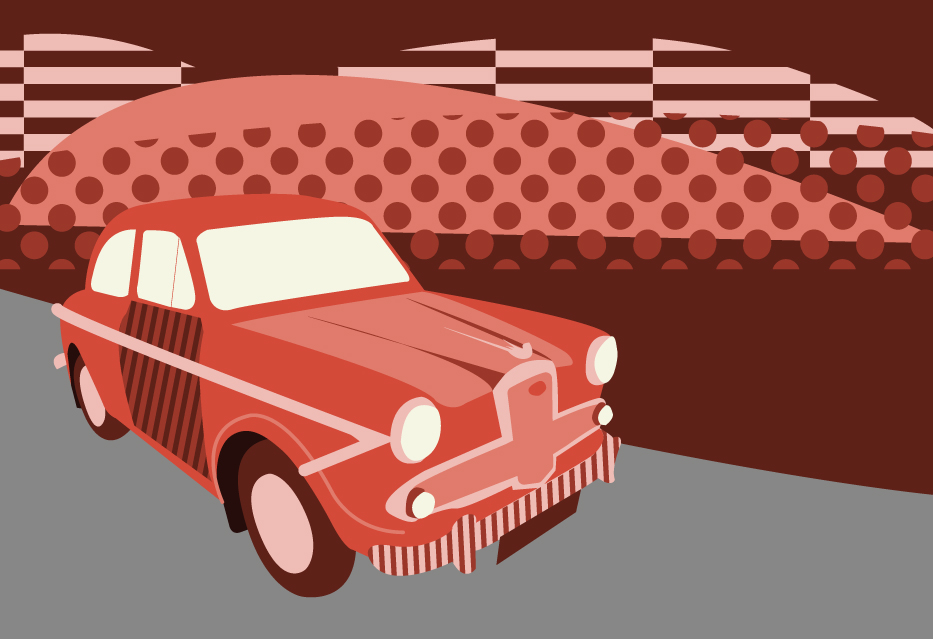It was far from the first supermini, but for more than 40 years the Ford Fiesta has held an iron grip on the small car sector.
Britain’s best-selling car for nine years on the spin up to 2017, as well as five times before that, the Fiesta has seduced more buyers than any other car on these shores since it was launched in 1976.
We look back at the early years of an understated legend.
Crisp, modern looks, simple engineering and the public’s thirst for an economy car big enough for all the family, plus luggage.
It’s not hard now to see why the Ford Fiesta has been such a phenomenal success, with more than 4.5million sold in the UK alone.
But back in the early 1970s, when Ford offered nothing smaller than the Escort in Europe, the company held genuine fears about the profitability of building such a small car – especially as it was yet to venture into the front-wheel-drive market, which would increase development costs.
In France, the ubiquitous Renault 5 was showing the way, while the Italians had the Fiat 127, the Germans the slightly later VW Polo and, in 1975, the British-built Vauxhall Chevette joined the fray.
Rising fuel prices and the practicality of the hatchback design were combining to make the supermini a smash hit across Europe, and a company as big as Ford couldn’t afford to ignore such a potentially vast new market.
In truth, plans for an all-new small car had been on the drawing board as far back as 1972 – even before the 1973 Arab oil crisis that saw the price of oil quadruple – under the name Project Bobcat.
Personally approved for development by Henry Ford II in the autumn of 1972, it was to be four long years before the finished car first went on sale in Europe, initially only available in left hand drive form.
A new factory was built in Valencia, Spain, and General Motors freely gave Ford the name Fiesta (party in Spanish), which had been used as a trim level on Oldsmobile station wagons.
Following a succession of carefully-crafted press leaks from late 1975, the all-new Fiesta was on display at Le Mans in June 1976 before finally going on sale in France and Germany in September of that year.
A rather grandiose launch video from 1976 – it’s nearly two minutes before you actually see the new car perched on a rock – spoke of how the oil shocks that had emptied the streets years earlier had marked a shift in consumer demand.
And rather than abandon the motor car (imagine!), “man resolved to cling to his comforts. He would meet the challenge of change. He would adapt his lifestyle, not surrender it”.
Climate change was but a glint in a scientist’s eye at the time – this was all about combating the rising cost of motoring, though the slow growth of two-car families looking for an economical second car also played a part.
Ford set out “to blend the comfort man demands with the economy he now needs” and, being late to the supermini party, knew it “must produce the most outstanding small car the world had ever seen”.
Frustratingly for UK dealers and customers, the new car wasn’t on sale in right hand drive form until February 1977, and the privately-obtained test car driven on the continent by Autocar in October ‘76 was a left hooker.
Early road test – worth waiting for?
Autocar’s test featured a 1.0L model, powered by a four-cylinder Valencia 957cc engine producing 45 bhp at 6,000rpm, though an 1,117cc engine was also offered at launch.
So was Ford’s smallest car yet worth the wait? And should UK buyers in the market for a new car hang on for another few months while Europe’s roads slowly filled with Fiestas?
“We would say that without doubt it is a new concept, bringing fresh standards of space, refinement and sheer driving fun to the economy car and, as such, it’s certainly worth the wait,” said the magazine.
Despite the antiquated origins of the pushrod engine, which dated back to the Anglia, Autocar said it was “astonishing to find how responsive it is, how free from valve gear noise, and how willingly it revs”.
“Fiesta is one of those cars which feels lively and responsive even before one has accelerated through into top gear,” said the road tester.
“It revs easily away without any roughness or hesitance, and there is a suggestion of crispness about the exhaust note which adds to the cheerful ‘let’s go’ character of the car.”
While the gearchange was a little notchy by Ford standards, sharp handling and steering made the car “delightfully controllable” and road and wind noise were minimal.
By modern supermini standards, overall fuel consumption of around 35mpg doesn’t sound great, but it was in keeping with its chief rivals.
In conclusion, Autocar said that while the Fiesta looked very similar to its competitors, it “brings a touch of flair, driver enjoyment and all-round efficiency to the small car market”.
“One can expect Ford to have looked very hard at their rivals, and to have gone into everything very carefully; when one drives the new car, these expectations are certainly confirmed, and the product fulfills one’s high hopes.”
Like our illustration of the Ford Fiesta at the beginning of the article?
Download a free high-quality poster version here.
Right car, right time
Ford had delivered the right car, at the right time, and the Fiesta was an immediate sales success, with the company’s typically wide range of trim levels – from Base, through Popular Plus to Ghia and S – catering for different budgets.
It seems the British public had been waiting for a small car bearing the blue oval, and by 1978 it was the nation’s best-selling supermini – a position it has never relinquished.
Of course it helped that Ford’s publicity machine was second to none, with CAR magazine describing some of the hyperbole surrounding the car’s UK launch as “hysterical drivel”.
But people were clearly convinced, with one London land developer taking one away to test and then returning to place an order for 35 Fiestas to put in the garages of the 35 flats he was trying to sell.
In March 1977, the magazine pitched the new Ford up against the VW Polo, Peugeot 104, Renault 5, Fiat 127 and Mini 1000 – and found it coming up short, though that mainly appears to stem from its lack of personality.
“Lack of character is the Fiesta’s only serious fault – if it can be classed as such,” it said. “It just didn’t seem to have any sort of positive attraction, whereas there is something very definite by way of personality about all the other baby cars.”
The Fiesta was beaten by the VW and both French cars – not that Ford would have lost too much sleep over it; their brand, in Britain at least, was far more trusted than their European competitors.
To the masses, the Fiesta was neat, reliable and cheap to run – and assembled just down the road in Dagenham (alongside production in Valencia).
The Ford Fiesta Supersport
There had already been a Ghia and Sport versions created with a 1.3-litre Kent crossflow engine before Ford tested the embryonic sports hatch market with the now rare and celebrated Fiesta Supersport in 1980.
The Supersport couldn’t be called “hot”, with no more power than the standard 66bhp car, but its more aggressive and purposeful styling were to prove the launchpad for the XR2 that came a year later, and today’s ST models.
It was equipped with the Series X bodykit, with wheelarch extensions, a lower boot spoiler and front splitter combined with 13-inch RS alloy wheels and round driving lamps supplementing the standard square headlights.
Body graphics completed the look of a car only available in black, diamond white, silver and red, with either red or black chequered interior trim unique to the model.
Only 3,000 cars were made, which accounts for its scarcity today (there were only 16 on the road in early 2018), but it is without doubt one of the most significant of all Fiestas, given its legacy.
Arrival of the Fiesta XR2
The success of the Supersport, and the bigger Ford Escort XR3, paved the way for the introduction of the sporty XR2 in 1981 – the first 100mph Fiesta.
It was an immediate success, with a peppy 1.6-litre engine delivering 84bhp allied to fine roadholding and eye-catching looks.
Round headlights replaced the standard car’s rectangular units, with a bodykit largely carried over from the Supersport set off by the now-famous ‘pepperpot’ alloy wheels.
The XR2 quickly became a boy-racers’ dream – affordable to buy, relatively cheap to run and mechanically simple.
The car lit the blue touch paper on the baby hot hatch market, and by 1982 it was joined by British Leyland’s MG Metro and Fiat’s repackaged 127 GT, with CAR magazine getting the three together for a group test.
For a time, until the Mazda MX-5 arrived in 1989, the more practical sports hatches replaced the two-seater rag-tops as the fun cars for the masses.
CAR said they packed “people as well as punch”, and “prove, if proof be needed, that neither comfort nor practicality has to be sacrificed for entertainment”.
The three-car test wasn’t an entirely equal one, with the Ford’s 1600cc engine larger than the 1.3-litre MG and Fiat, while it also cost £900 more than the 127 and £350 more than the Metro.
The Ford had a clear power advantage – it was the only car of the three capable of hitting 60mph in under 10 seconds and also scored highly on roadholding.
But was it worth the extra cost? Not according to the magazine, which admitted to finding the car something of an enigma – doing everything right but lacking “that intangible quality which turns an able car, which the XR2 is, into an endearing one”.
For £900 less, it plumped for the Fiat as its overall winner.
All of which just goes to show that the car-buying public don’t pay much attention to car reviewers, or at least they didn’t at the time, because the Fiesta – deemed lacking in character – had sold 2 million models by 1982, Britain’s best-selling car.
Ford Fiesta Tuareg
We can’t leave the mark I without taking a quick look at the Fiesta Tuareg, a 1979 concept car that foreshadowed the baby SUVs of today.
A collaboration between Turin’s Ghia and the Ford Design Centre in Dearborn, the car was designed around the standard floorpan as a “practical, off-road, desert Fiesta”.
It retained the original car’s 1117cc Kent engine and, despite its “off-road” intentions, was front wheel drive – so really, not dissimilar to today’s small crossover SUVs.
A raised suspension was stiffened, and Goodyear Terra 26-in off-road tyres were mounted on 7J steel rims.
Ghia gave the car an estate-like rear end thanks to an extended roofline, while the car was also 6.7 inches longer than the car on which it was based.
A split tailgate gave better loading practicality, while the louvred bonnet, black steel nudge bars, heavy-duty roof rack and roof-mounted spotlights gave the car a purposeful look.
Adrian Flux Classic Car Insurance
A massive front spoiler, wide arches and skirts made the Tuareg look more like a desert racer than a practical off-roader…maybe that was the intention.
In any event, after it was shown at the Geneva Motor Show, in 1979, it was never seen again.
Ford Fiesta mark II
In all, 2.5 million mark I cars had been produced when the face-lifted mark II arrived in August 1983.
With such a winning formula on its hands, Ford didn’t need to change too much, making the front end rounder and barely changing the rear at all apart from a bootlid mirroring the swage lines on the sides.
The interior saw bigger changes with an all-new dashboard, while under the bonnet the same 957cc and 1117cc engines continued alongside a new 1.6-litre diesel adapted from the Escort.
Under the skin, the mark II did have some useful updates, including five-speed gearboxes, high security Chubb locks, and an automatic option.
Given the development costs that had gone into the Fiesta of 1976, it was understandable that Ford should want to stretch out its investment for as long as possible.
But new competitors were arriving in the sector all the time, not the least the brilliant Peugeot 205 and the Vauxhall Nova, and the continuing success of the Fiesta was a triumph of marketing and customer loyalty more than anything else.
Motor magazine got their hands on a 1.1L Fiesta for its January 1984 issue, noting that most of the major changes to the updated Fiesta were to improve fuel consumption, an area where the old car ‘had been taking its severest mauling from newer rivals”.
The rounded nose reduced drag co-efficient, while the larger engine bay made space not only for the more frugal diesel, but the 1.3 and 1.6-litre CVH due to replace the old crossflows later in 1984.
The smaller engines were altered for improved torque and economy, with higher compression ratios, a new camshaft and new exhaust manifold.
On the 1.1-litre tested, a Variable Venturi carburetter replaced the previous fixed choke instrument.
All these changes helped to put the Fiesta’s economy up with the class leaders, Motor’s testers achieving an impressive 39.7mpg under hard driving.
The new car had improved on the old one, but Motor looked forward to an all-new car in the not too distant future.
“In 1985 or ‘86 we may well see a radically new Fiesta that will set new standards. Time will tell. In the meantime, Ford have smoothed away the wrinkles of the existing design before they cold take hold for good,” it said.
“As a result, there’s still a lot that’s good about the Fiesta and, indifferent ride apart, very little that’s wrong. For the time being, that’s enough.”
It was actually 1989 before that all-new Fiesta came along, but the Ford-loving public didn’t care that its favourite supermini was so long in the tooth and it still outsold technically superior cars throughout the decade.
Fiesta XR2 – the second coming
The mark 2 Fiesta came in a typically wide range of trim levels – Popular, Popular Plus, L, and Ghia, plus the sporting models, the 1.4S and, eventually, the range-topping XR2.
The XR2, which was not available when the reshaped car was launched, gained a power boost over its predecessor, thanks to the 96bhp CVH engine previously seen in the XR3, allied to the new five-speed gearbox.
It gained a larger bodykit, and sold in huge numbers despite ferocious competition from the Peugeot 205GTi (stunning in 1.9-litre guise), Renault 5GT Turbo, MG Metro Turbo, and Fiat Uno Turbo i.e.
All these cars comfortably outperformed the XR2, which was zippy rather than out-and-out fast, yet the Ford was still a major player in the small hot hatch market.
Testing the XR2 in June 1984, Motor magazine dubbed it “the Mini Cooper reborn”, maybe because of its combination of peppy performance, fantastic handling and, importantly, low price.
It undercurrent all of its rivals by at least £400, “almost too good to be true”.
A 0-60mph time of 8.7 seconds, compared to its predecessor’s 9.6, was a notable improvement, but it somehow felt quicker than that.
Faster, more economical and smoother riding than its forerunner, Motor said the new XR2, “as a practical (if rather noisy) fun car, makes the grade in the way that the Mini Cooper did all those years ago and, at well under £6,000, it represents outstanding value.
“It’s far from perfect, and Peugeot’s more modern 205GTi is, in many ways, a better car. When it comes to sitting down with your bank manager, however, you’ll need to be a slick talker to argue against the Ford.”
Autocar called it “exceptionally good fun to drive”, but What Car? opted for the Peugeot in a group test also including the Metro Turbo.
It’s summary of the XR2, however, the magazine hits upon the most salient point of all – that the XR2 didn’t need to be the best small hot hatch to be a massive seller.
“Although the XR2 falls a little flat in the excitement stakes, it’s still very much a commonsense Ford and that alone will sell it to many buyers who want a fast little car which has less of the mechanical complexity found on the other two here,” it said.
It’s also worth noting that Ford never produced a truly hot version of the Fiesta; for those wanting a fire-breathing hatchback it had the Escort RS Turbo from 1984 to 1990, followed by the RS Cosworth from 1992.
Like our illustration of the Ford Fiesta at the beginning of the article?
Download a free high-quality poster version here.
Fiesta Turbo Technics
However, a company called Turbo Technics did – its conversion boosting power to nearly 130bhp and turning the XR2 into not only a 205GTi-beating monster, but a rival to the big boys of the hot hatch scene.
Motor tested one in December 1984, under the headline “too hot to handle”, and found that “three days of under-bonnet surgery at Turbo Technics will see an XR2 emerging with the same muscle as two of the hot hatch league’s most potent members – the Lancia Delta HF and Fiat Strada Abarth”.
Turbo Technics claimed a 0-60mph sprint in under 7 seconds, which would leave a Golf GTi trailing in the dust, let alone its direct baby hatch competitors.
The turbo-charged XR2 was the ultimate sleeper hatch, with just some discreet turbo badges giving the game away, and Ford was impressed enough to honour its factory warranty.
Whether the standard XR2 was able to cope with the extra power was another matter, however, with Motor describing the car’s tendency to take a “kamikaze lunge for the wrong side of the road” on anything other than perfectly flat surfaces if the go-pedal is pushed too hard.
The key was to drive “with circumspection” – “think of it as a boisterous dog – it’s less troublesome when kept on a lead,” it said.
The conversion did come at a price though, £1,438 on top of a standard car, which made it, at £7,395, more expensive than all of its chief rivals. But faster, too.
The modern Fiestas
By the time a completely new Fiesta was introduced in 1989, the first two versions – both based on that 1976 launch car – had sold 4 million models.
Its best ever year in the UK was 1987, when 150,000 were sold but, even though sales remained strong right up to the end of the road for the mark II, it had fallen well behind its rivals by almost every measure barring popularity.
The mark 3, launched in 1989 and based on an all-new platform, brought it into the modern era, and each successive generation since – up to the current eighth incarnation – has built on the success of its predecessor.
In 2014, it became the best-selling vehicle ever in the UK, surpassing the 4,105,961 registrations achieved by the Ford Escort, which would still hold the record but for its name-change to the Focus.
These days, it’s more popular than ever, selling more cars in the UK than any other every year since 2009.
Ford may have been a late entrant to the supermini market, but it’s fair to say they got it spot on.
Insurance from Adrian Flux
Get competitive classic car insurance for your Ford Fiesta from Adrian Flux.
Features can include:
- Agreed value
- Limited mileage discounts
- Owners club discount
- Laid up cover
- Wedding hire cover




















